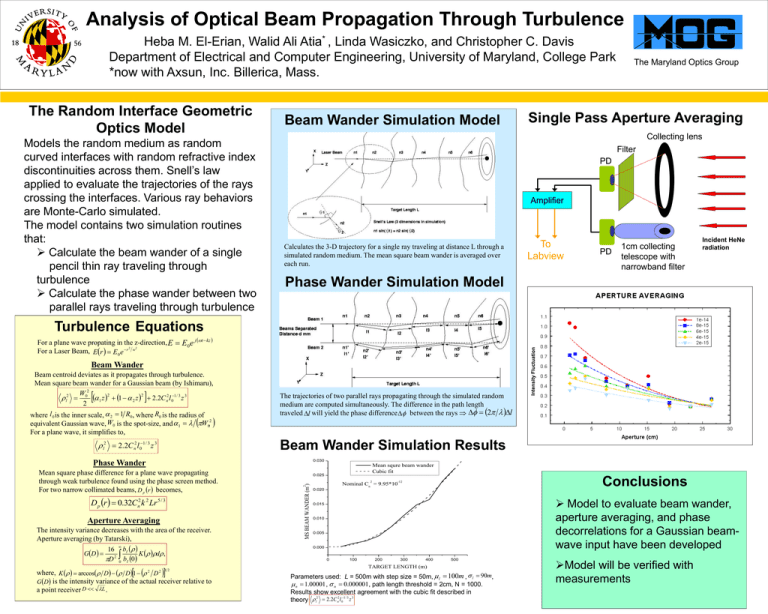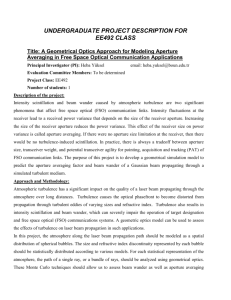Analysis of Optical Beam Propagation through Turbulence
advertisement

Analysis of Optical Beam Propagation Through Turbulence Heba M. El-Erian, Walid Ali Atia* , Linda Wasiczko, and Christopher C. Davis Department of Electrical and Computer Engineering, University of Maryland, College Park *now with Axsun, Inc. Billerica, Mass. The Random Interface Geometric Optics Model Models the random medium as random curved interfaces with random refractive index discontinuities across them. Snell’s law applied to evaluate the trajectories of the rays crossing the interfaces. Various ray behaviors are Monte-Carlo simulated. The model contains two simulation routines that: Calculate the beam wander of a single pencil thin ray traveling through turbulence Calculate the phase wander between two parallel rays traveling through turbulence Beam Wander Simulation Model The Maryland Optics Group Single Pass Aperture Averaging Collecting lens Filter PD Amplifier Calculates the 3-D trajectory for a single ray traveling at distance L through a simulated random medium. The mean square beam wander is averaged over each run. To Labview PD 1cm collecting telescope with narrowband filter Incident HeNe radiation Phase Wander Simulation Model Turbulence Equations For a plane wave propating in the z-direction, E E0 e j t kz 2 2 For a Laser Beam, E r E0 e r w Beam Wander Beam centroid deviates as it propagates through turbulence. Mean square beam wander for a Gaussian beam (by Ishimaru), W02 2 1 z 2 1 2 z 2 2.2Cn2 l01 / 3 z 3 l 2 where l 0 is the inner scale, 2 1 R0, where R0 is the radius of 2 equivalent Gaussian wave, W0 is the spot-size, and 1 W0. For a plane wave, it simplifies to, The trajectories of two parallel rays propagating through the simulated random medium are computed simultaneously. The difference in the path length traveled l will yield the phase difference between the rays 2 l Beam Wander Simulation Results l2 2.2C n2 l 01 / 3 z 3 0.030 Phase Wander D p r 0.32Cn2 k 2 Lr 5 / 3 Aperture Averaging The intensity variance decreases with the area of the receiver. Aperture averaging (by Tatarski), 16 bI G D K d , D 2 0 bI 0 where, K arccos D D 1 D GD is the intensity variance of the actual receiver relative to a point receiver D L . 2 2 12 0.025 2 Conclusions -12 Nominal Cn = 9.95*10 2 MS BEAM WANDER (m ) Mean square phase difference for a plane wave propagating through weak turbulence found using the phase screen method. For two narrow collimated beams, D p r becomes, Mean squre beam wander Cubic fit 0.020 Model to evaluate beam wander, aperture averaging, and phase decorrelations for a Gaussian beamwave input have been developed 0.015 0.010 0.005 0.000 0 100 200 300 400 500 TARGET LENGTH (m) Parameters used: L = 500m with step size = 50m, l 100m , l 90m, n 1.00001 , n 0.000001, path length threshold = 2cm, N = 1000. Results show excellent agreement with the cubic fit described in theory l2 2.2C n2 l 01 / 3 z 3 Model will be verified with measurements







